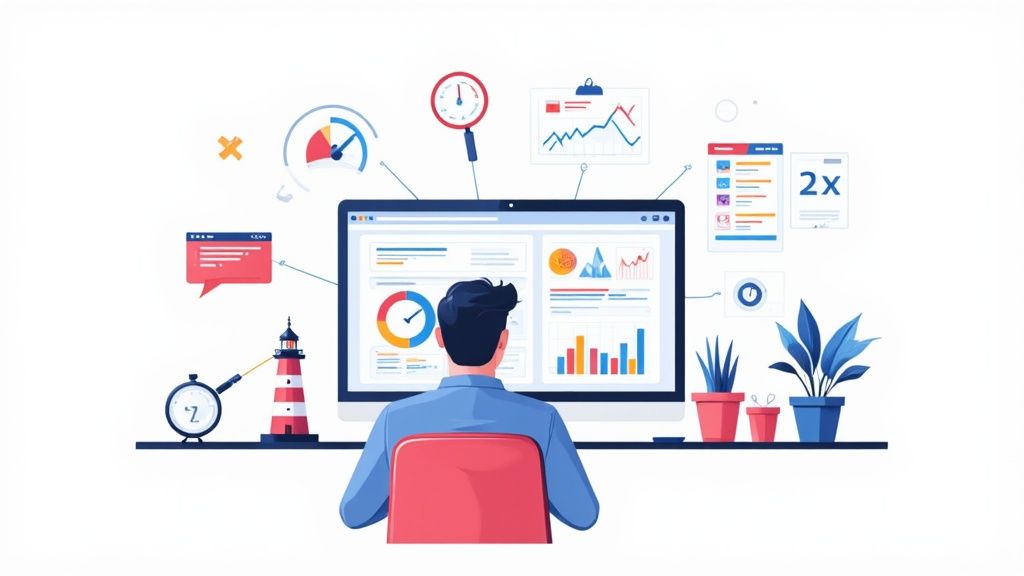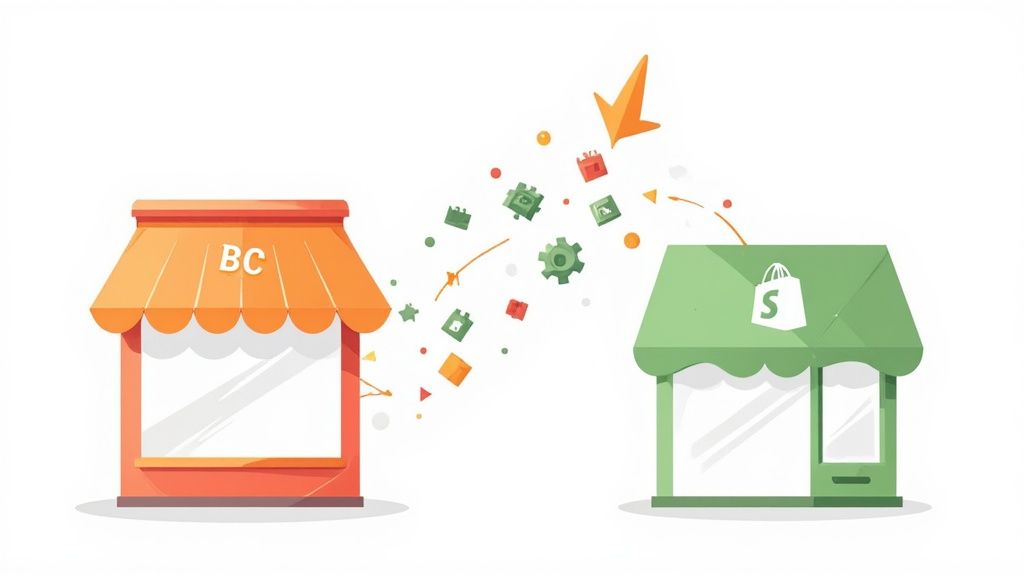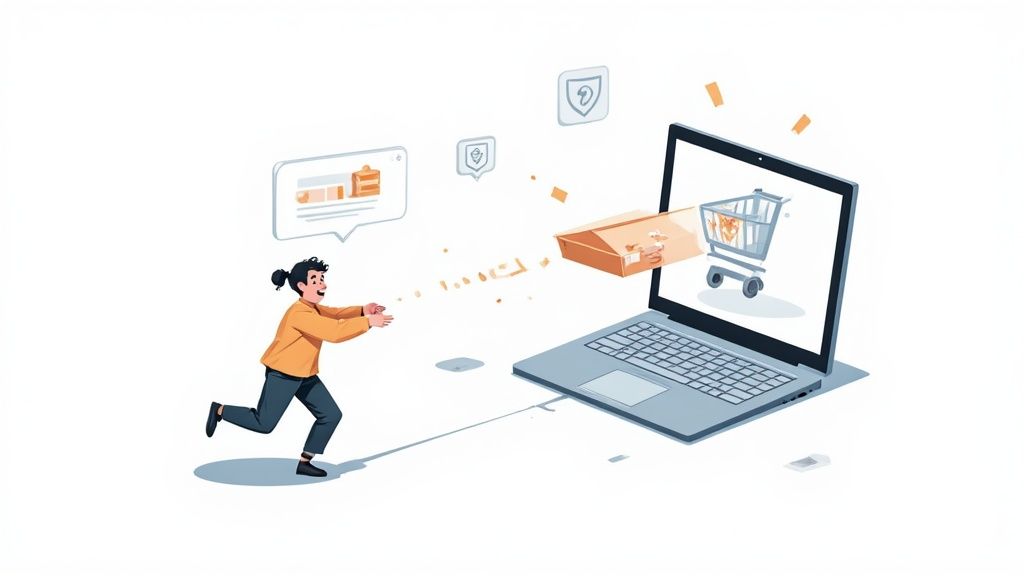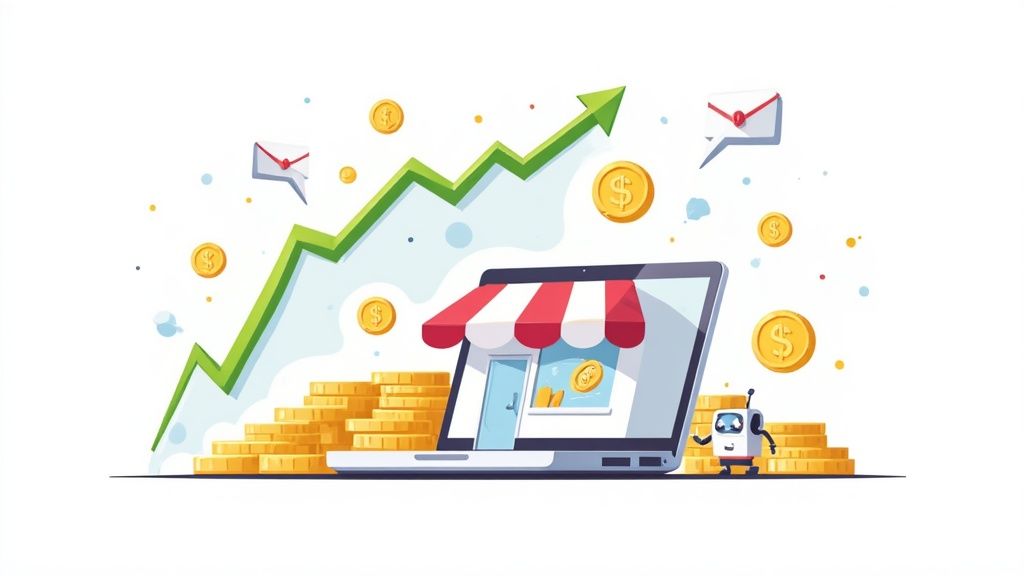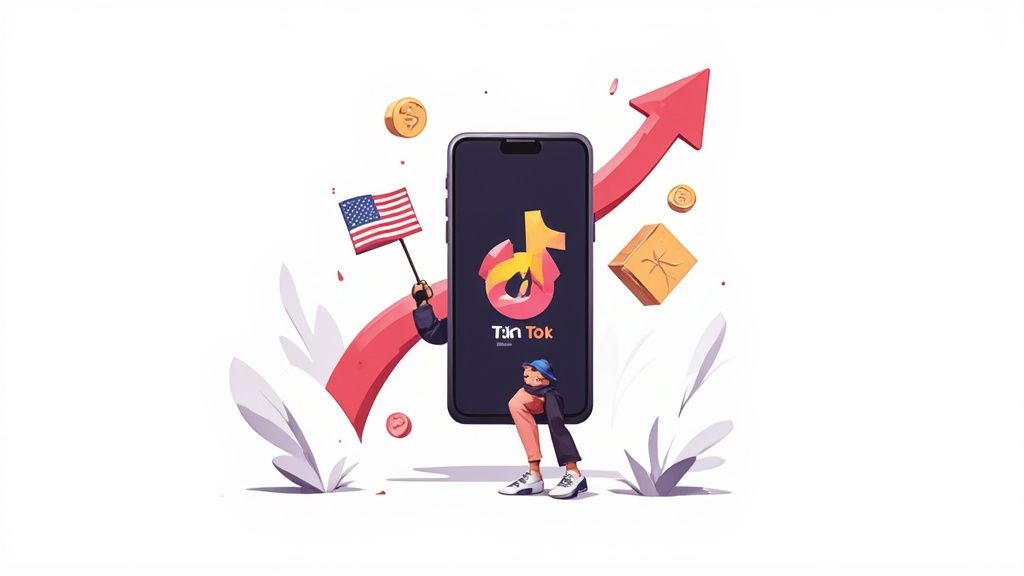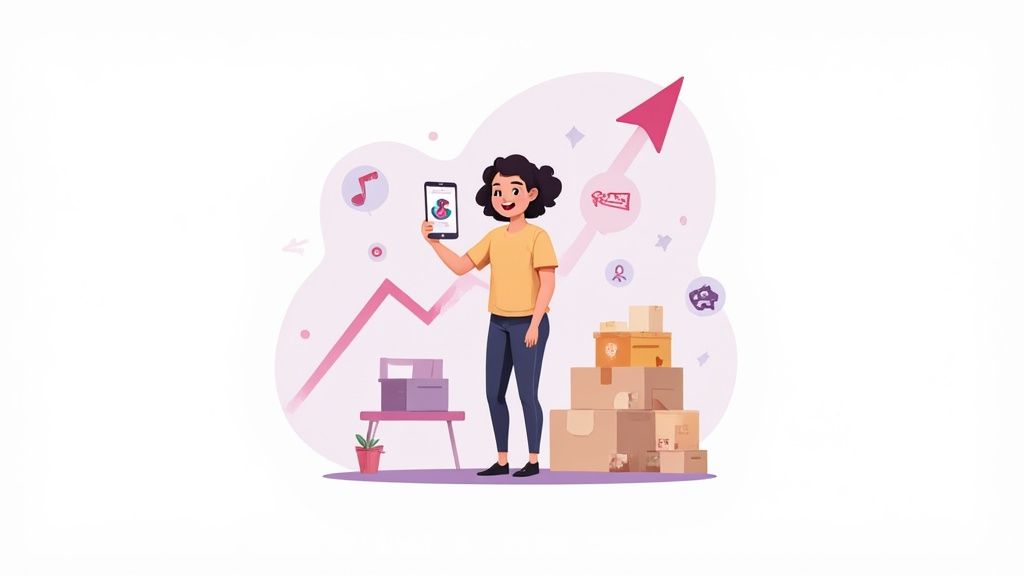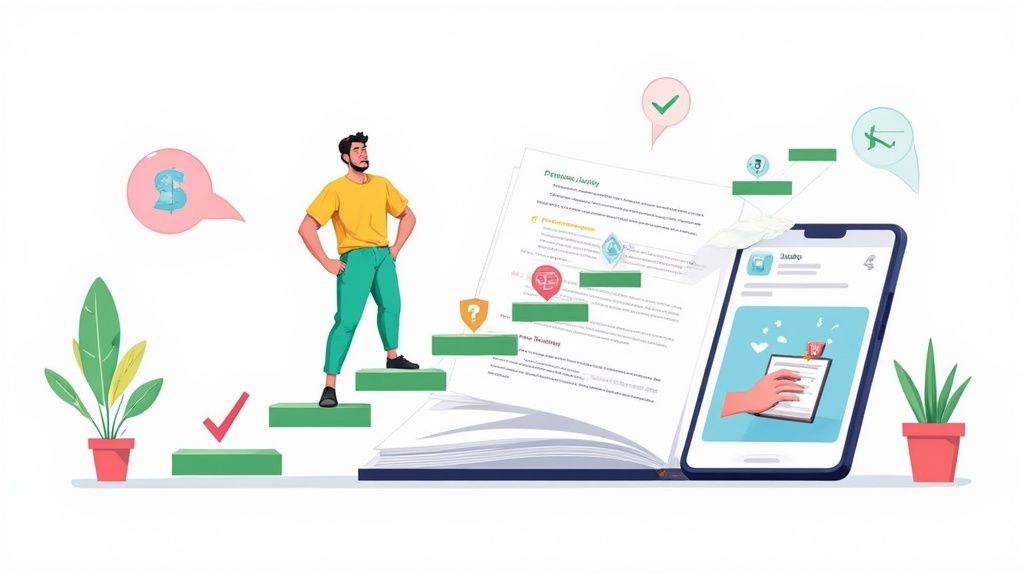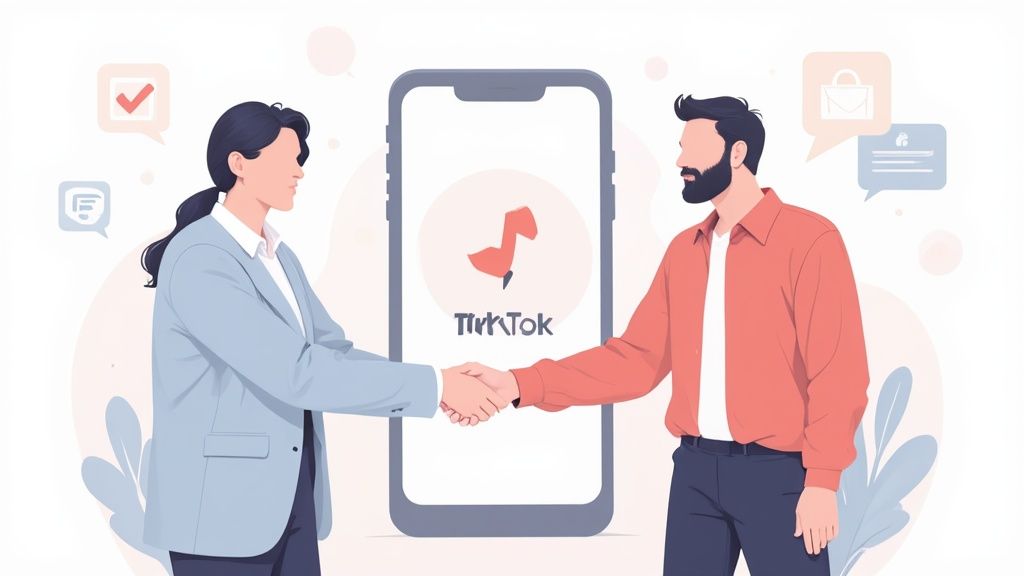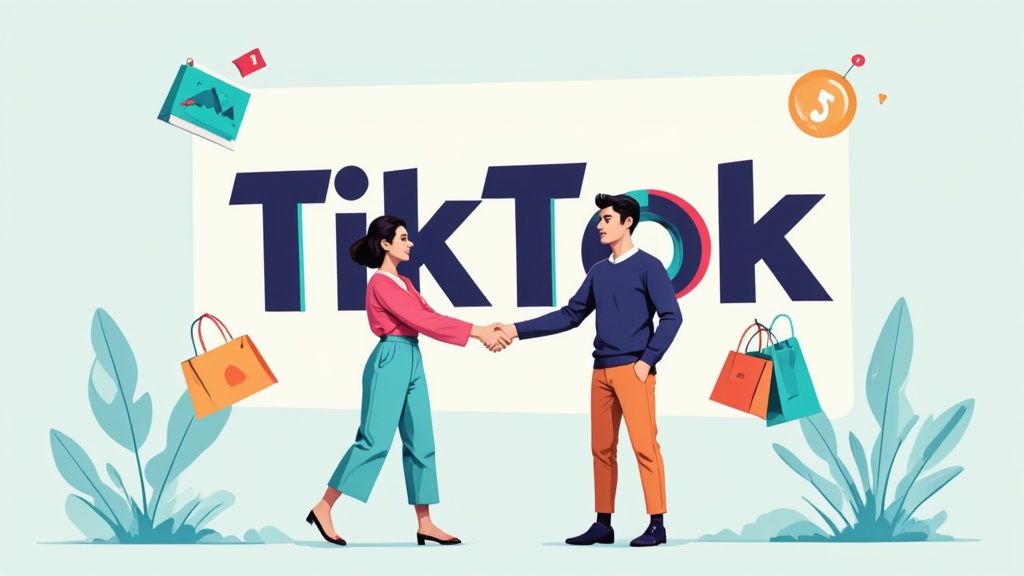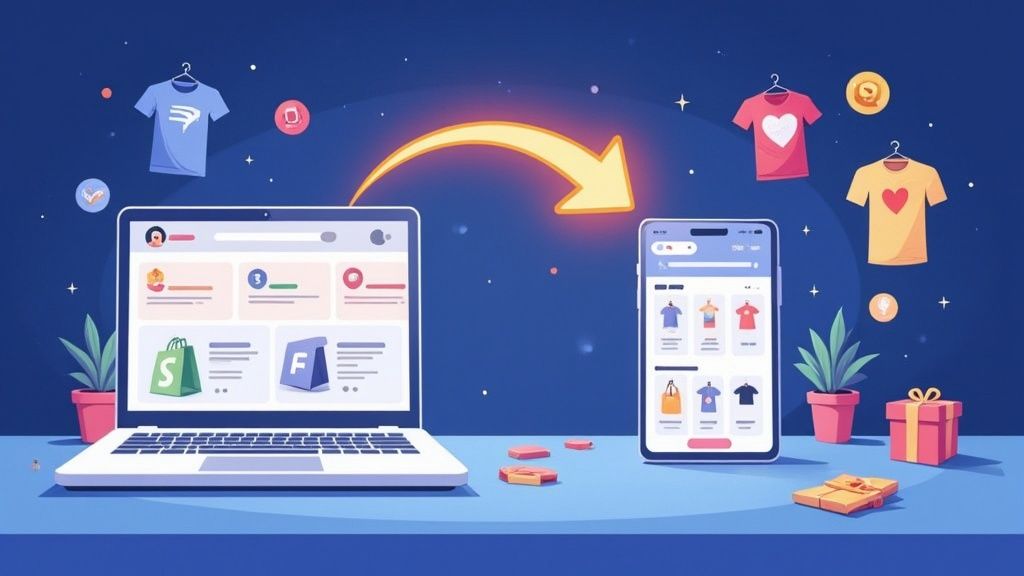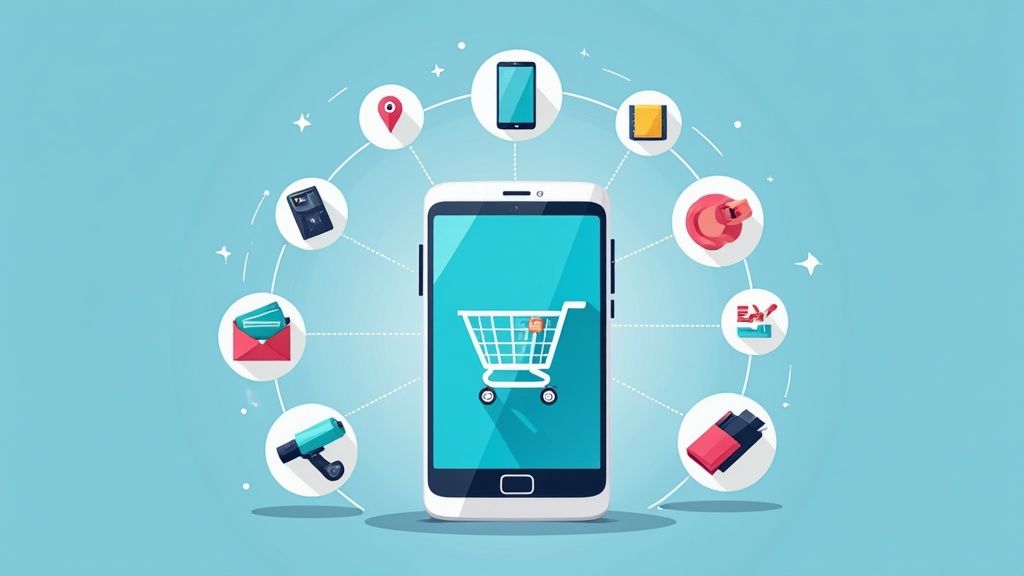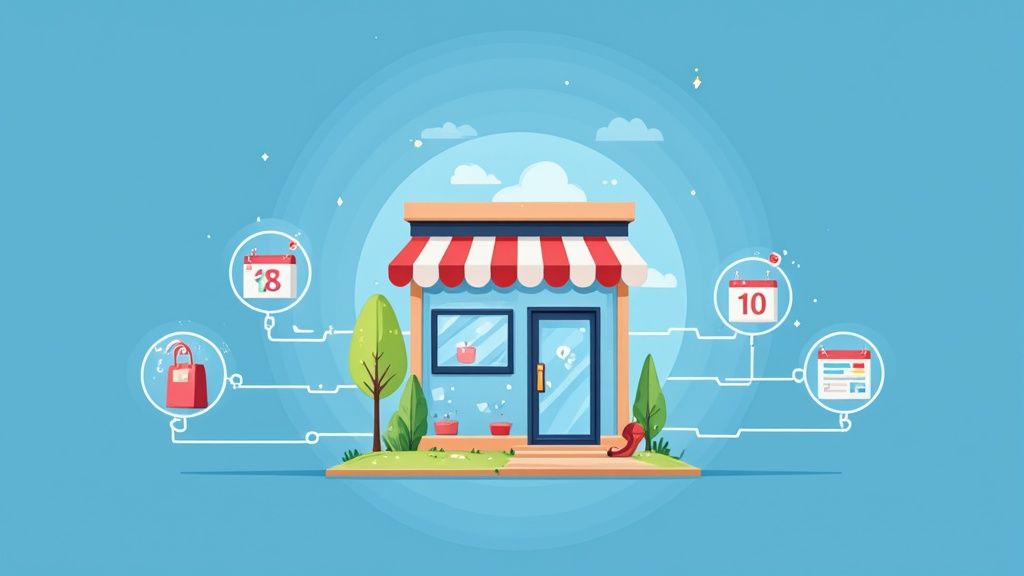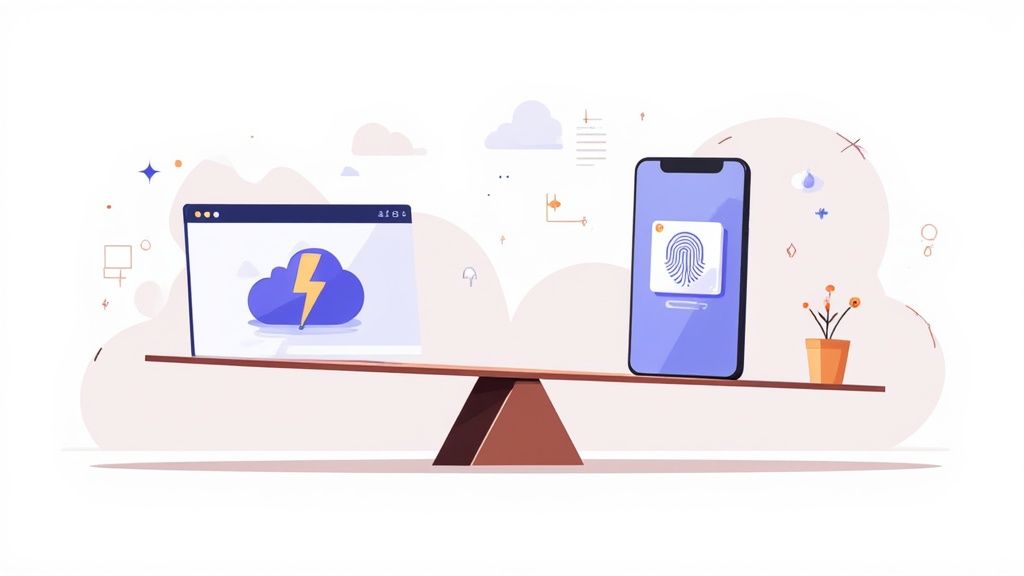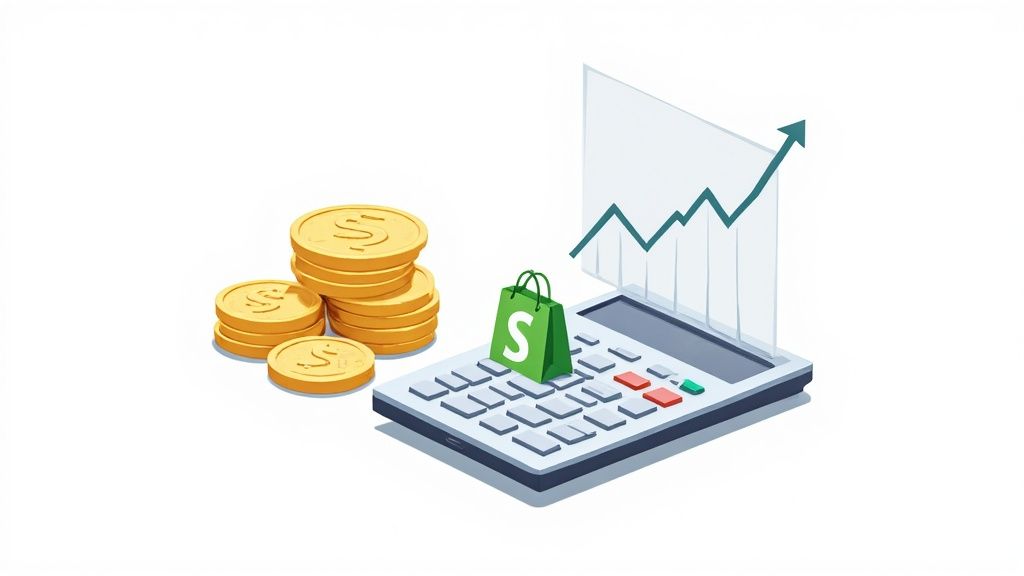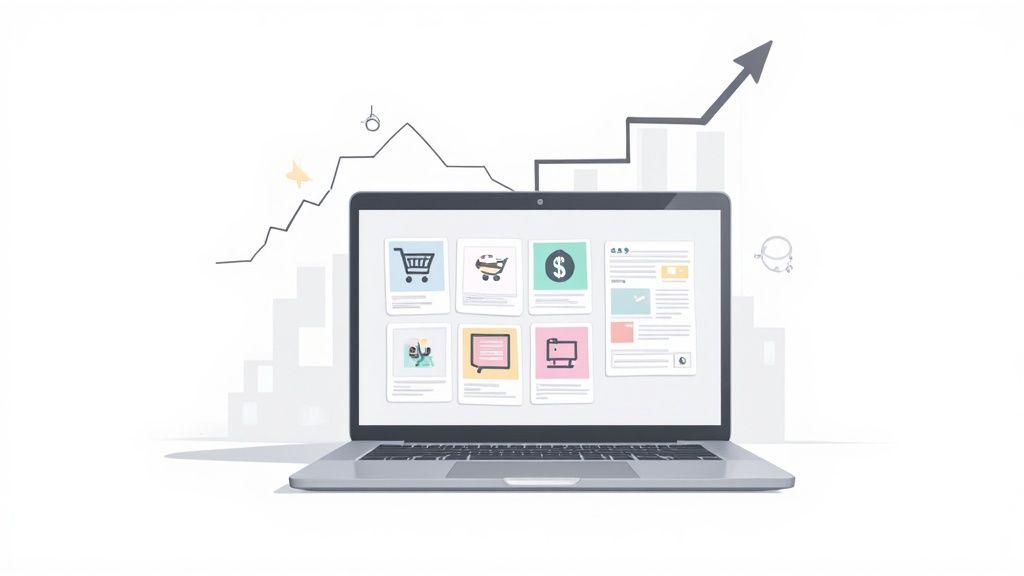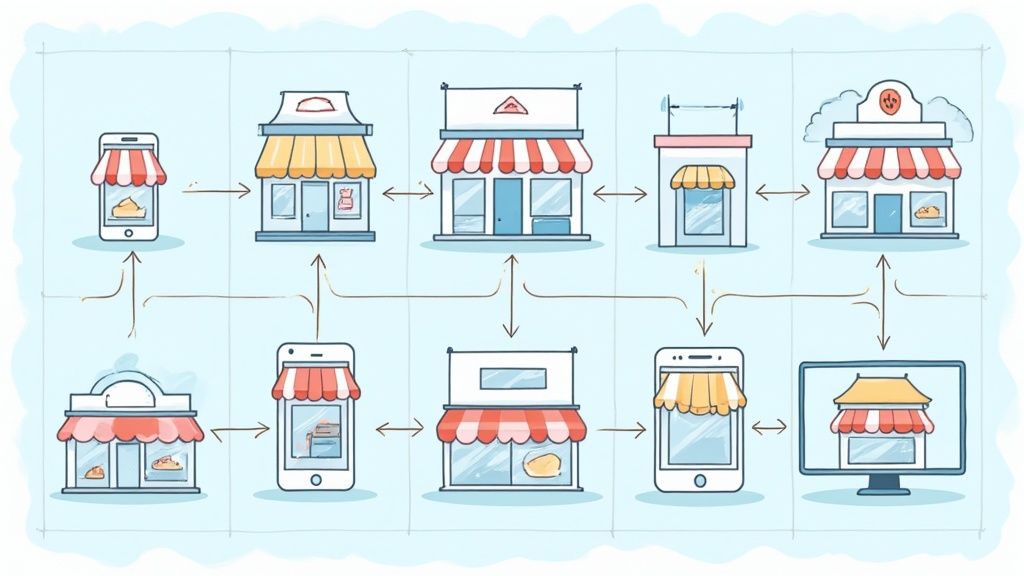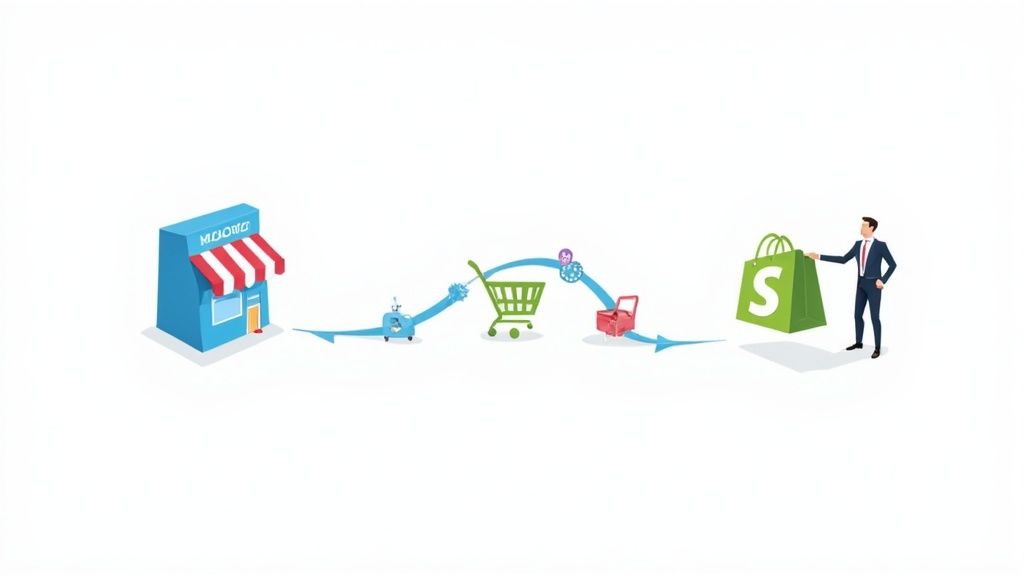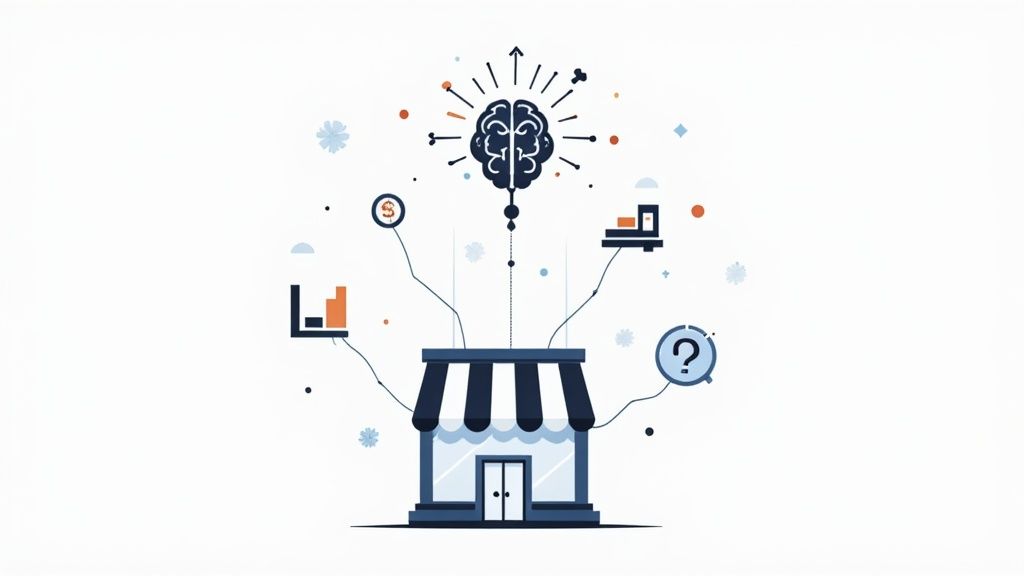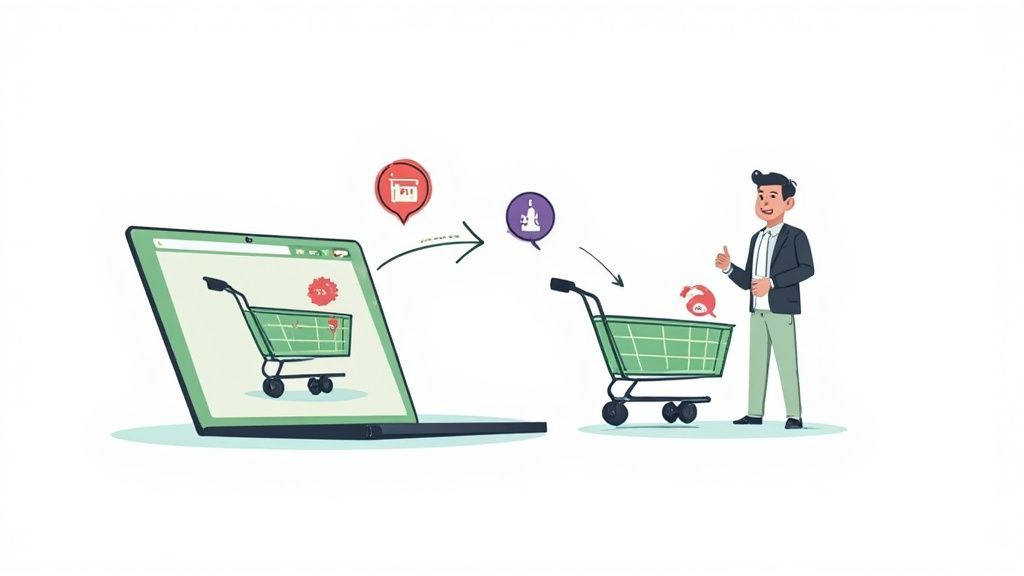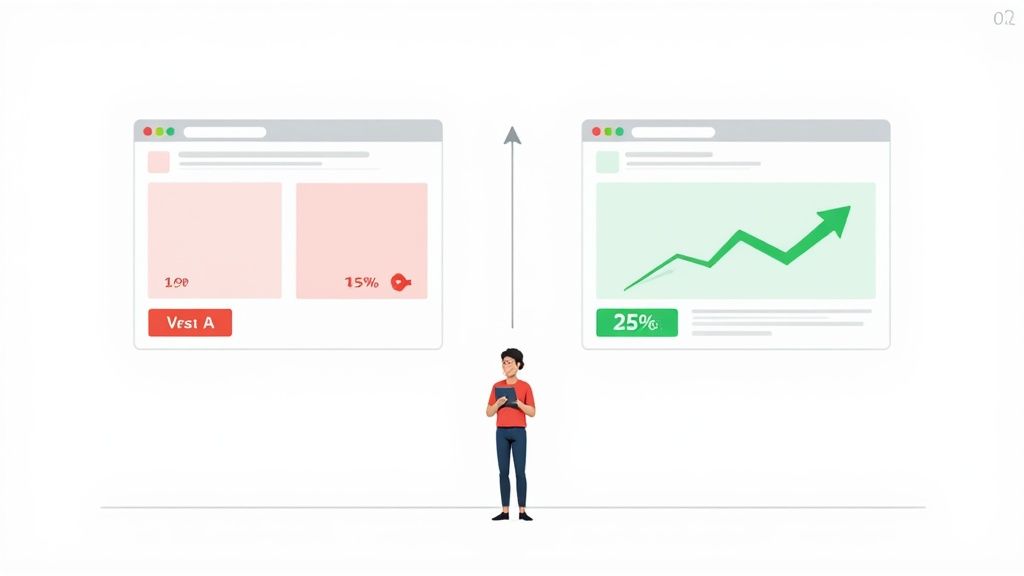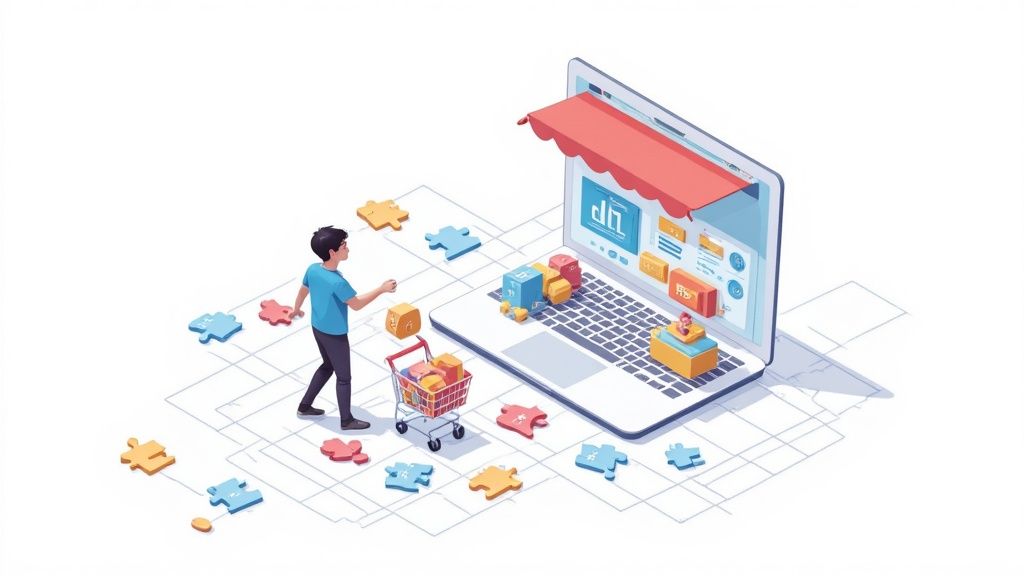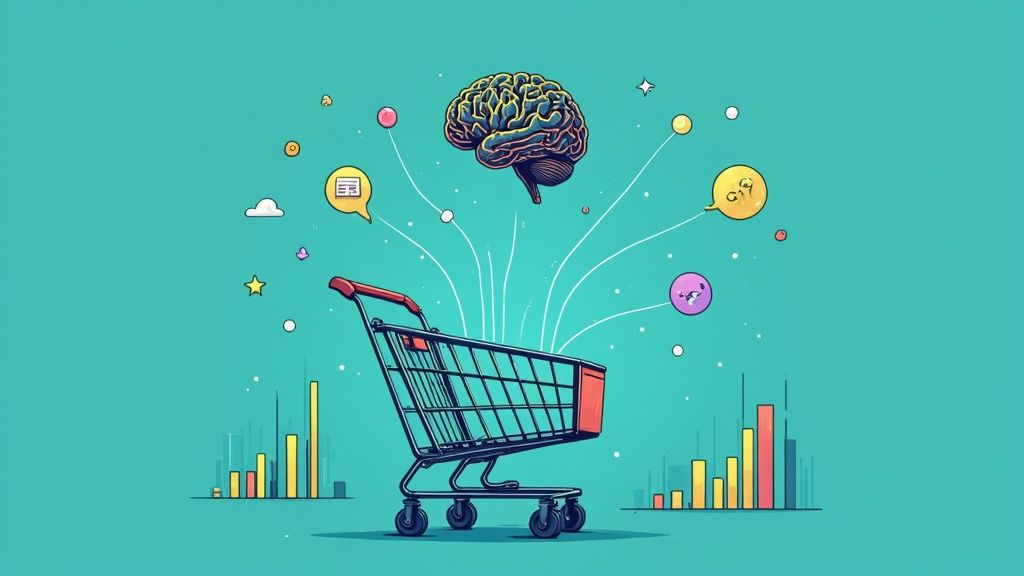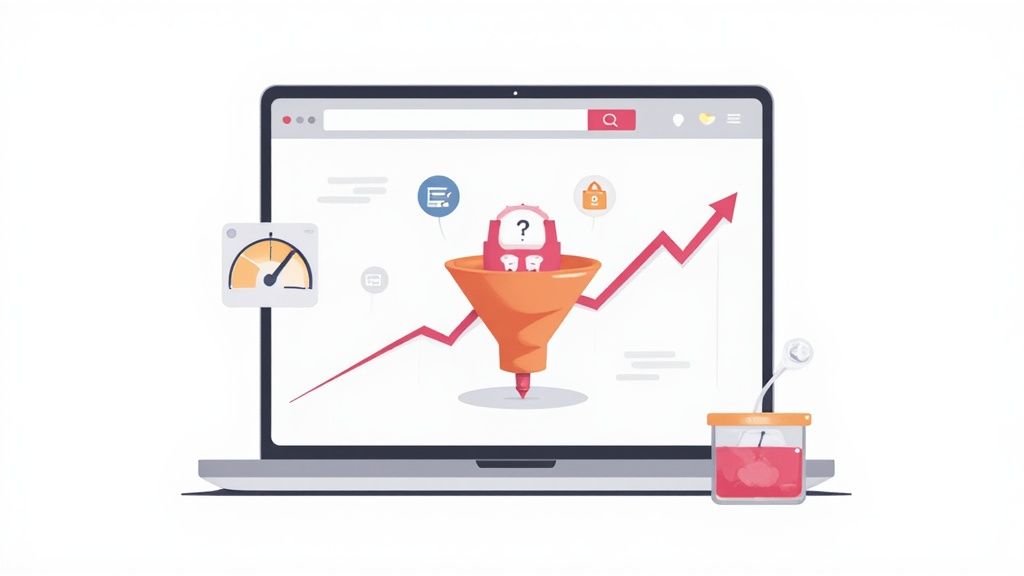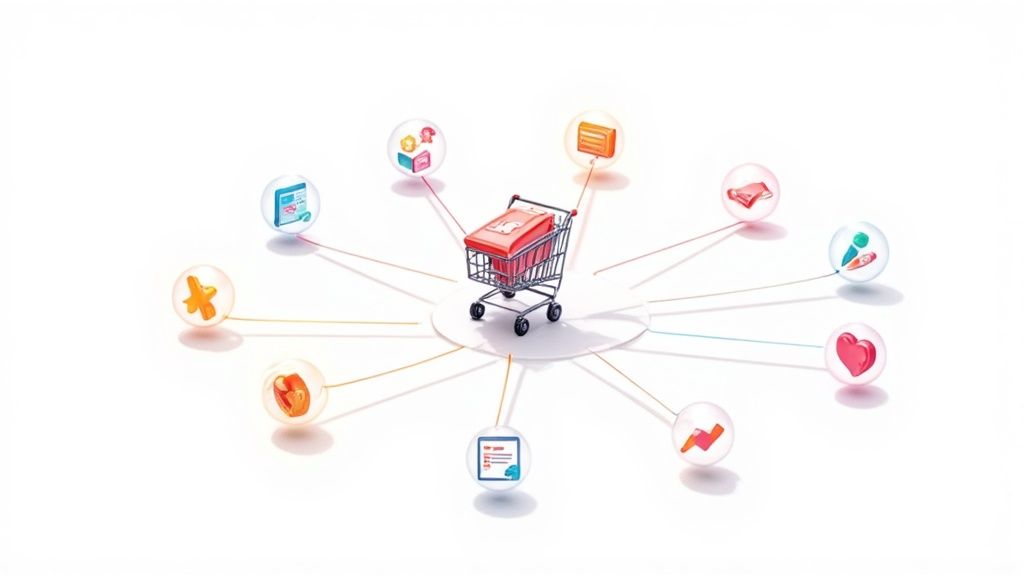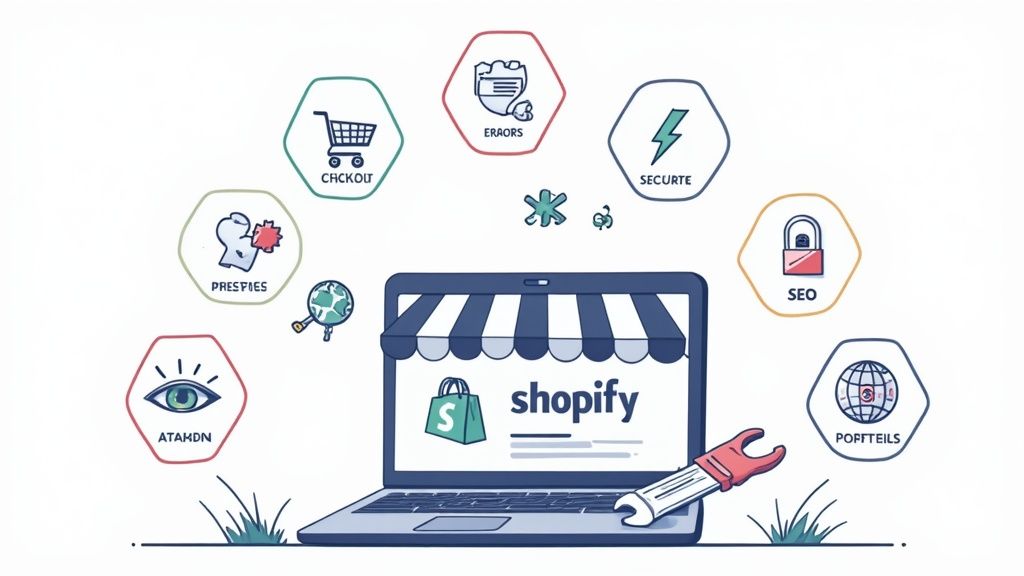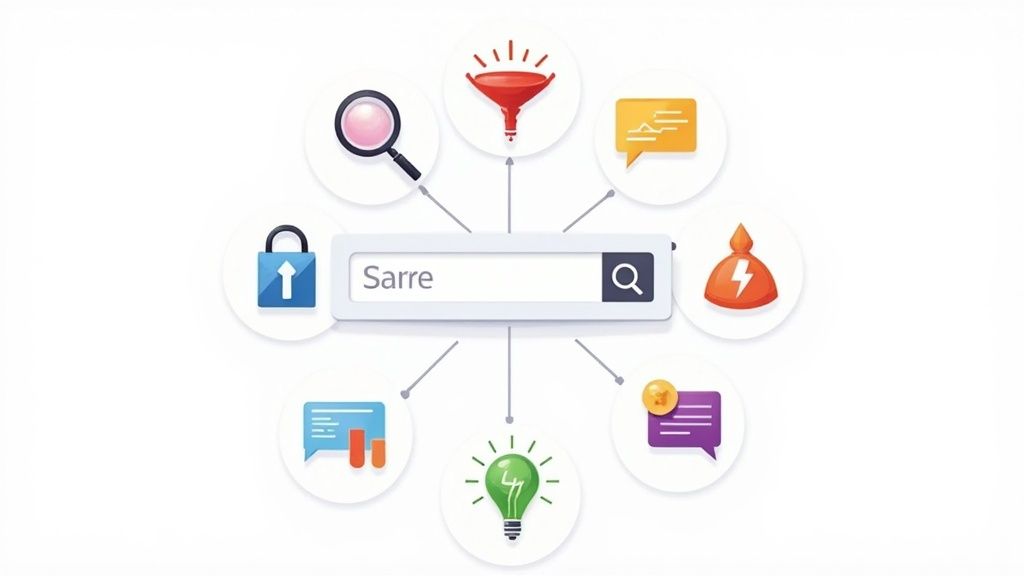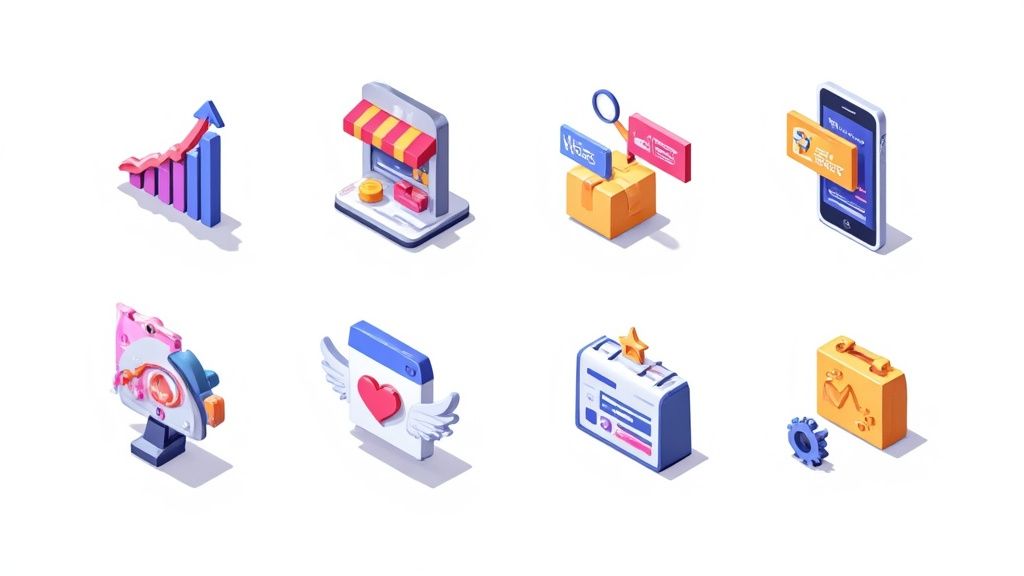
Elevate Your Online Store: UX Best Practices
In today's competitive eCommerce market, a functional online store is just the starting point. Customer expectations are higher than ever, shaped by the seamless experiences offered by industry giants like Amazon. Effective user experience (UX) is now essential for success, regardless of your business size.
The online shopping experience has evolved significantly. Features like product recommendations, once considered cutting-edge, are now standard. Modern UX focuses on anticipating customer needs, removing obstacles, and creating a smooth and enjoyable journey from product discovery to post-purchase engagement.
This shift is fueled by evolving technology, changing user behavior, and the growing demand for integrated experiences. From the rise of mobile commerce to the use of AI-driven personalization, a customer-centric approach is crucial. Success in eCommerce now hinges on understanding online shopping psychology, using data-driven insights, and constantly optimizing for conversion, retention, and customer satisfaction.
This article explores eight essential eCommerce UX best practices to help you create a high-performing online store. These principles span the entire customer journey, from initial browsing to checkout and beyond, enabling you to optimize for conversions, build customer loyalty, and thrive in the modern eCommerce environment.
Understanding the Customer Journey
A successful online store focuses on understanding and optimizing the customer journey. This means considering every touchpoint a customer has with your brand, from their first visit to your website to post-purchase follow-up.
Product Discovery: Make it easy for customers to find what they're looking for with intuitive navigation, robust search functionality, and personalized product recommendations.
Seamless Checkout: A streamlined checkout process is vital for minimizing cart abandonment. Offer multiple payment options, guest checkout, and clear order summaries.
Post-Purchase Engagement: Nurture customer relationships after the sale with personalized email marketing, exclusive offers, and proactive customer support.
Mobile-First Approach
With the majority of online shopping now happening on mobile devices, a mobile-first approach is no longer optional. Ensure your website is fully responsive, providing a seamless and enjoyable experience on all screen sizes.
Optimized Navigation: Simplify navigation for mobile users, focusing on essential features and minimizing clutter.
Fast Loading Speeds: Mobile users expect instant gratification. Optimize your website for speed to prevent frustration and bounce rates.
Touch-Friendly Design: Design elements should be easily tappable with fingers, ensuring a comfortable and intuitive mobile experience.
Building Trust and Credibility
Building trust is crucial for converting visitors into customers. Display clear contact information, secure payment badges, and customer testimonials to establish credibility and encourage purchases.
Secure Checkout: Emphasize the security of your checkout process with visible security badges and trust seals.
Transparent Policies: Clearly display your shipping, return, and privacy policies to build confidence and transparency.
Customer Reviews: Showcase positive customer reviews and testimonials to build social proof and encourage conversions.
1. Intuitive Navigation Design
Intuitive navigation is the foundation of a positive user experience for any e-commerce website. It's the guiding principle that allows customers to easily explore your online store, discover products, and complete purchases without any hassle. Without it, even the most appealing products and promotions can get lost in a confusing online maze, leading to frustrated customers, abandoned shopping carts, and ultimately, lost revenue. This makes intuitive navigation paramount for any successful e-commerce venture.

As e-commerce platforms evolved from basic online catalogs to the dynamic marketplaces we see today, the importance of intuitive navigation became increasingly apparent. Early websites often suffered from cluttered layouts and complex menus, making product discovery a difficult task. The emergence of user-centered design principles brought a much-needed shift towards cleaner, more logical navigation structures. Today’s online shoppers expect to find what they are looking for quickly and with minimal effort, regardless of the size or complexity of the online store.
Features of Effective E-commerce Navigation
Effective e-commerce navigation boils down to a few key features:
Logical Information Architecture: Organize your products in a way that makes sense to your target audience. This could be categorized by product type, brand, or even by how the product is used.
Simplified Menu Structures: Avoid overwhelming your users with too many choices. Keep menu labels clear and concise, logically grouping related items together.
Breadcrumb Navigation: Provide a clear visual path of the user's journey through your site. This allows for easy backtracking and a clear understanding of their current location within the store.
Sticky Navigation Bars: Keep the main navigation menu visible as users scroll down the page, ensuring constant and easy access to key site sections.
Advanced Search Functionality with Filters: Give users the power to refine search results based on specific criteria, such as price, size, color, or brand. This empowers them to quickly find exactly what they need.
Category Organization that Matches User Mental Models: Design your category structure around how users naturally think about your products. For example, a clothing store might organize first by gender, then by clothing type.
Pros and Cons of Intuitive Navigation
Intuitive navigation offers many advantages:
Reduces Cognitive Load for Shoppers: Makes finding products effortless.
Decreases Bounce Rate and Abandonment: Keeps users engaged, encouraging them to complete their purchase.
Increases Product Discoverability: Helps users stumble upon products they might not have otherwise considered.
Improves Conversion Rates: Simplifies the buying process, leading to more sales.
Builds Trust Through Predictability: Creates a sense of familiarity and control, building customer confidence.
However, some challenges exist:
Balancing Simplicity with Comprehensive Navigation: Offering a broad range of products while maintaining clean navigation can be tricky.
User Testing and Optimization: Thorough user testing is crucial to ensure navigation is genuinely intuitive.
Ongoing Refinement: Regular updates and adjustments are necessary as inventory and user behavior change.
Examples and Tips for Excellent E-commerce Navigation
Several major brands demonstrate best practices in navigation:
Amazon: Department-based navigation with expandable categories.
Apple: Minimalist navigation with clear product categories.
Sephora: A robust filtering system for refined product searches.
Wayfair: Room-based navigation helps users visualize product placement.
Here are some practical tips for implementing intuitive navigation:
Search Analytics: Analyze search data to understand user intent and refine navigation accordingly.
Card Sorting Exercises: Use card sorting to understand user categorization preferences.
"7±2" Rule: Limit main navigation categories to around 7 (plus or minus 2) to avoid overwhelming users.
Consistent Cross-Device Navigation: Maintain consistent navigation across all devices.
Predictive Search with Autocomplete: Help users find products quickly with predictive search.
Visible Homepage Link: Always include a clear link back to the homepage.
By prioritizing intuitive navigation, e-commerce businesses significantly improve the user experience. This leads to higher engagement, better conversion rates, and ultimately, greater success. It's a fundamental element that deserves careful planning and continuous improvement.
2. Mobile-First Responsive Design
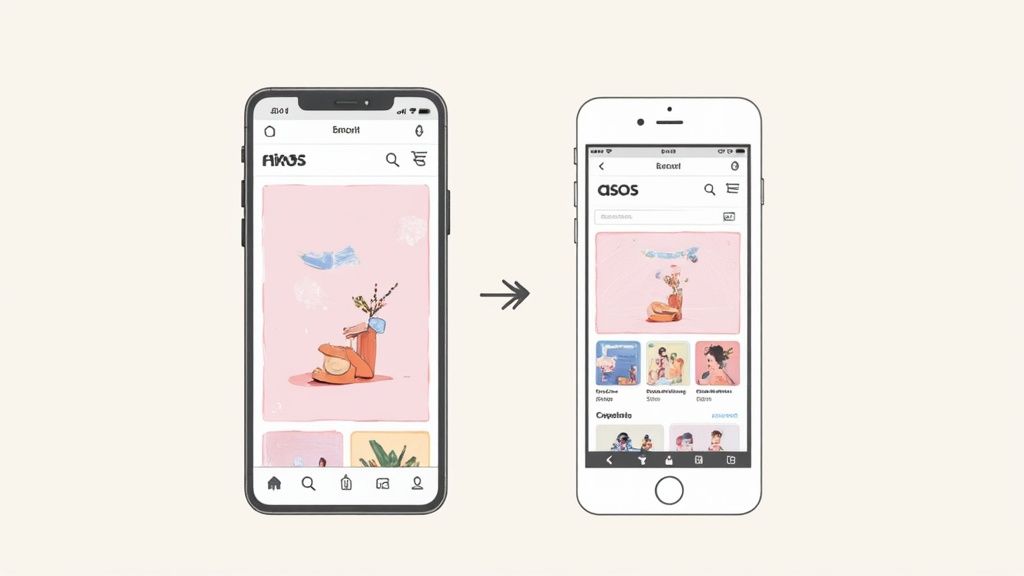
Mobile shopping is now the dominant force in eCommerce. Ignoring this trend means losing customers and revenue. Mobile-first responsive design isn't just a bonus anymore; it's essential for any successful online store. This design philosophy prioritizes the mobile user experience first, then adapts to larger screens. This ensures your eCommerce website performs flawlessly on any device.
This approach recognizes how vital mobile shopping is, making sure every user enjoys an optimized experience, regardless of their device, screen size, or orientation. It’s a complete shift from the traditional "desktop-first" way of thinking. Rather than shrinking a desktop site down to mobile size, you begin with the limitations of a small screen and build outward.
This naturally results in a more streamlined, efficient, and user-friendly experience on every device.
Key Features of Mobile-First Responsive Design
- Fluid grid layouts: Content adjusts automatically to fit different screen sizes.
- Touch-friendly interface elements: Buttons and links are sized for easy tapping on touchscreens.
- Performance optimization for slower connections: Images load quickly, even on mobile networks.
- Simplified checkout process for mobile users: Streamlined forms and payment options simplify mobile buying.
- Appropriately sized buttons and form fields: No more zooming or squinting to fill out forms.
- Content prioritization for smaller screens: Key information comes first, with other content easily accessible.
Pros of Mobile-First Design
- Captures the mobile shopping audience: Reach your customers where they are – on their smartphones.
- Improves SEO: Google uses mobile-first indexing, so your mobile site is key for ranking.
- Reduces development costs: It's cheaper than maintaining separate mobile and desktop websites.
- Consistent brand experience: Build trust with a unified experience across all devices.
- Future-proof design: Adapts to new screen sizes and resolutions.
Cons of Mobile-First Design
- Significant redesign for existing sites: Moving from desktop-first can be a large project.
- Maintaining complex features: Ensuring consistent functionality across screen sizes needs careful planning and testing.
- Longer initial development: Mobile-first sometimes requires more upfront planning.
Real-World Examples
- Etsy: Provides a seamless transition and consistent browsing experience.
- ASOS: Offers mobile-optimized product galleries and an easy checkout.
- Warby Parker: Features a touch-friendly interface with large buttons.
- Shopify: Provides mobile-optimized themes for merchants.
Practical Tips for Implementation
- Test site speed: Use Google's Mobile-Friendly Test to find performance issues.
- Implement touch targets: Buttons should be at least 44x44 pixels for easy clicking.
- Use progressive disclosure: Hide less important information on mobile to prioritize essential content.
- Optimize images: Compress images for faster loading without losing quality.
- Consider gestures: Use swiping and pinching to improve mobile navigation.
- Test on real devices: Ensure optimal performance and usability on physical devices.
Evolution and Popularization
Luke Wroblewski popularized the “Mobile First” concept, and Ethan Marcotte pioneered responsive web design. Google's adoption of mobile-first indexing solidified its importance for SEO and online success.
Mobile-first responsive design is vital for any modern eCommerce business. Prioritizing mobile users helps you reach more shoppers, boost SEO rankings, and build a more user-friendly online store. This directly improves conversions and builds customer loyalty, ultimately impacting your bottom line.
3. Streamlined Checkout Process

The checkout process is the final, and often most crucial, stage of the customer journey. A smooth and efficient checkout experience minimizes friction and complexity, directly impacting both conversion rates and revenue. Optimizing this stage is paramount for emerging eCommerce businesses, growing brands, and even established Shopify Plus merchants.
This is precisely why a streamlined checkout is a core element of eCommerce best practices. By reducing the number of steps involved, eliminating distractions, and providing clear guidance, retailers can significantly decrease cart abandonment rates and boost their bottom line.
Key Features of a Streamlined Checkout
A streamlined checkout experience typically incorporates the following features:
- One-page or minimal-step checkout flow: Condensing the process reduces the chance of a customer abandoning their purchase.
- Guest checkout option: Offering a guest checkout option removes a significant barrier for first-time buyers hesitant to create an account.
- Progress indicators: A visual representation of the checkout stages keeps customers informed and encourages completion.
- Real-time form field validation: Immediate feedback on errors prevents frustration and ensures accurate information capture.
- Multiple payment options: Offering diverse payment methods, including digital wallets like Apple Pay and Google Pay, caters to customer preferences and increases conversion potential.
- Address autocomplete functionality: Simplifying data entry with address autocomplete reduces errors and saves customers valuable time.
- Order summary with transparent pricing: Clearly displaying all costs, including shipping and taxes, builds trust and avoids surprises before the final purchase confirmation.
Pros and Cons of Streamlined Checkout
Here's a quick look at the advantages and disadvantages:
The concept of streamlined checkout gained traction with the rise of eCommerce giants like Amazon. Their (now-expired) one-click ordering patent revolutionized online shopping. Similarly, PayPal popularized simplified online payments, and Stripe made developer-friendly payment processing a reality. Today, platforms like Shopify offer dynamic checkout options, further enhancing the customer experience. ASOS provides an excellent example of a mobile-optimized checkout, while Apple's integration of Apple Pay exemplifies the power of frictionless payments.
Practical Tips for Implementation
- Remove distractions: Eliminate unnecessary navigation during checkout to maintain focus on the purchase.
- Save user information: Offer account creation incentives and leverage stored payment information for faster repeat purchases.
- Communicate shipping costs: Be transparent about shipping costs early in the process to build trust.
- Implement inline validation: Provide real-time feedback on form fields to minimize errors.
- Allow cart editing: Enable users to edit cart contents within the checkout flow for a better user experience.
- Use address verification: Ensure accurate delivery information with address verification.
- Offer multiple payment methods: Include digital wallets to cater to a wider audience and offer convenient options.
By implementing these best practices, eCommerce businesses of all sizes can significantly enhance their checkout experience, reduce cart abandonment, and drive revenue growth. Constantly optimizing and testing this critical stage of the customer journey is essential for remaining competitive.
4. High-Quality Product Visualization
High-quality product visualization is key for online businesses. It bridges the gap between the digital shopping experience and the tactile nature of brick-and-mortar stores. This means providing detailed, interactive visual information, ranging from professional product photography to engaging 360-degree views and videos. Even Augmented Reality (AR) can play a role, allowing customers to interact with products virtually before making a purchase.
Why is product visualization so important? It directly impacts key metrics like conversion rates, return rates, and customer engagement. When customers can thoroughly examine a product online, they are more likely to feel confident in their purchase, leading to higher sales and fewer returns. This translates to a smoother, more satisfying customer journey overall.
Features of Effective Product Visualization
Effective product visualization incorporates several key elements:
- High-resolution, zoomable product images
- Multiple angles and views of the product
- 360-degree product rotation
- Contextual/lifestyle photography
- Product videos and demonstrations
- AR try-on or placement tools
- User-generated content integration
Pros of High-Quality Product Visualization
- Reduces purchase uncertainty: Customers can inspect products closely, minimizing surprises upon delivery.
- Decreases return rates: Clear visuals lead to fewer returns due to unmet expectations.
- Increases conversion rates: Compelling visuals enhance perceived value and encourage purchases.
- Enhances user engagement: Interactive elements like 360-degree views and AR keep users engaged.
- Competitive advantage: High-quality visuals can set a business apart in a crowded marketplace.
Cons of High-Quality Product Visualization
- Resource intensive: Creating quality assets can be expensive and time-consuming.
- Page load times: Large image and video files can slow down website performance.
- Technical expertise: Advanced implementations like AR require specialized skills.
- Regular updates: Visuals must be updated when product designs or features change.
Examples of Successful Implementation
Several companies effectively utilize high-quality product visualization:
- Wayfair: Their "View in Room 3D" feature uses AR (www.wayfair.com).
- IKEA: The IKEA Place app lets users visualize furniture in their homes (www.ikea.com).
- Sephora: Their Virtual Artist lets customers try on makeup virtually (www.sephora.com).
- Warby Parker: Customers can virtually try on eyeglasses (www.warbyparker.com).
- Amazon: Many products have 360-degree views (www.amazon.com).
Tips for Implementation
Here are a few tips for implementing high-quality product visualization:
- Maintain consistent style, lighting, and scale in product images.
- Optimize images for web performance without sacrificing quality.
- Showcase products in context with lifestyle photography.
- Include detailed shots of important product features and textures.
- Implement lazy loading to improve page load speeds.
- Use videos to demonstrate complex products or highlight features.
- Thoroughly test AR features on various devices and operating systems.
Evolution and Popularization
Companies like Apple, with their focus on product photography, set early standards for eCommerce visuals. IKEA was an early adopter of AR, showcasing its potential. Amazon, with its product photography guidelines, solidified the importance of consistent, high-quality visuals. Advancements in AR and 3D modeling continue to push the boundaries of product visualization, creating more immersive online shopping experiences.
5. Personalized User Experiences
In today's competitive ecommerce market, a generic approach just won't work. Personalized user experiences use data, behavior patterns, and preferences to create unique shopping journeys for each customer. This means showing relevant products, recommendations, and content, ultimately leading to increased engagement, higher average order value, and stronger customer loyalty. By creating experiences that feel custom-designed, you're building relationships, not just selling products.
This personalized approach is a crucial ecommerce best practice because it directly benefits both businesses and customers. Businesses see improved conversion rates and customer lifetime value, while customers enjoy a more convenient and enjoyable shopping experience.
Features of Personalized Experiences
- Product Recommendations: Suggesting items based on browsing history, past purchases, and similar user profiles (e.g., "Customers who bought this also bought...").
- Personalized Search Results: Tailoring search results to individual user preferences and past searches.
- Customer Segmentation: Grouping customers based on shared characteristics to deliver targeted messaging and offers.
- Dynamic Content: Displaying content based on user attributes like demographics, location, or purchase history.
- Customized Email Campaigns: Sending personalized email recommendations, promotions, and abandoned cart reminders.
- Saved Preferences and Favorites: Allowing users to save preferences and favorite items for easier future purchases.
- Personalized Pricing or Promotions: Offering tailored discounts or promotions based on individual customer behavior or loyalty.
Pros of Personalization
- Increased Average Order Value: Relevant recommendations encourage larger purchases.
- Improved Customer Loyalty and Retention: Personalized experiences make customers feel valued, fostering loyalty.
- More Engaging Shopping Experiences: Tailored content keeps customers interested.
- Improved Product Discovery: Helps customers find relevant products they might otherwise miss.
- Higher Conversion Rates: Personalized experiences guide customers toward purchases.
Cons of Personalization
- Data Management: Requires responsible data collection and management, complying with privacy regulations.
- Privacy Concerns: Transparency is crucial to avoid customer privacy concerns.
- Data Dependency: Effective personalization requires significant data.
- Algorithm Refinement: Algorithms need ongoing monitoring, testing, and refinement.
Examples in Action
- Amazon: A pioneer of product recommendations with "Recommended for you" and "Customers who bought this also bought."
- Netflix: Provides personalized content recommendations, a model applicable to product recommendations.
- Spotify: "Discover Weekly" is a great example of algorithmic personalization for product discovery.
- Stitch Fix: Offers a personal styling service based on individual style profiles.
Tips for Implementation
- Start Simple: Begin with basic features like displaying recently viewed items.
- Transparency is Key: Be open about data collection and personalization practices.
- Human Touch: Combine algorithms with human curation.
- A/B Testing: Continuously refine algorithms through A/B testing.
- User Input: Allow users to provide preferences and feedback.
- Context Matters: Consider factors like location, season, and time of day.
- Progressive Strategy: Develop a strategy that evolves with your data.
Evolution and Popularization
Amazon's early adoption of recommendation engines paved the way for widespread personalization. Spotify demonstrated the power of algorithmic personalization, while platforms like Salesforce Einstein offer enterprise-level tools for advanced personalization. As AI and machine learning continue to develop, personalized experiences will become even more sophisticated and essential for ecommerce success.
6. Transparent Product Information and Pricing
In the world of eCommerce, trust is everything. Building that trust, encouraging customer loyalty, and ultimately driving sales relies heavily on transparent product information and pricing. This means giving customers complete, honest, and readily available details about products, pricing, availability, and related policies. By eliminating surprises, you foster confidence and encourage conversions. Transparency is no longer a bonus; it's a requirement for success in the competitive online marketplace.
Providing clear and accurate product information is essential for building trust and reducing customer frustration. Hidden fees, vague descriptions, and confusing return policies can damage a brand's reputation and lead to lost sales. Transparency, conversely, empowers customers to make informed decisions, resulting in greater satisfaction and fewer returns. It's a win-win for everyone.
Key Aspects of Transparent eCommerce
- Comprehensive Product Descriptions: Don't just list basic details. Include specific measurements, materials, care instructions, and even potential use cases.
- Clear Pricing (Including All Fees): Show the full price upfront, including taxes, shipping, and any other fees. No surprises at checkout!
- Accurate Inventory Information: Real-time inventory updates help manage customer expectations and prevent disappointment.
- Detailed Shipping Costs and Timeframes: Offer various shipping options with clear pricing and estimated delivery times.
- Honest Product Specifications and Limitations: Don't hide any product limitations. Honesty builds trust with your customers.
- Transparent Return and Refund Policies: Easy-to-understand return policies give customers confidence in their purchase.
- Verified Customer Reviews and Ratings: Authentic reviews and ratings provide social proof and build credibility.
Advantages and Disadvantages of Transparency
Pros:
- Increased customer trust and loyalty
- Reduced customer service inquiries
- Lower return rates
- Improved conversion rates
- Brand differentiation in a crowded market
Cons:
- Potential for highlighting product limitations
- Requires ongoing maintenance of accurate information
- Balancing comprehensive information with clean design can be challenging
Examples of Transparency in Action
- Everlane: Known for "radical transparency," Everlane reveals the true cost of their products, from manufacturing to materials and labor.
- Patagonia: Provides detailed information about product sourcing and environmental impact.
- Allbirds: Offers a clear breakdown of product materials and sustainability practices.
- B&H Photo: Provides in-depth technical specifications and real-time inventory updates.
Practical Tips for Implementing Transparency
- Upfront Pricing: Display all costs from the beginning, not just at checkout.
- Detailed Specifications: Provide clear and specific measurements and technical information, avoiding marketing jargon.
- Honesty is Paramount: Be upfront about both the positives and negatives of your products.
- Robust Review System: Use a verified review system for authenticity.
- Real-Time Inventory: Keep inventory information updated to prevent issues.
- Comprehensive FAQs: Create a detailed FAQ section to address common customer questions.
The Rise of Transparency
The demand for transparency in eCommerce has grown due to both consumer demand and brand recognition of its value. Everlane's “radical transparency” played a significant role, alongside the efforts of consumer groups and evolving industry standards. Companies like REI, with their detailed product specs and honest reviews, further solidify this trend.
Transparent product information and pricing isn’t just a fleeting trend; it’s a core change in how eCommerce operates. Embracing transparency is key for businesses looking to build trust, foster loyalty, and succeed in today's online marketplace.
7. Fast Site Performance and Loading Speed

In the fast-paced world of ecommerce, speed reigns supreme. For online retailers, site performance optimization, focusing on quick loading times and smooth navigation, is no longer a luxury but a critical need. This technical bedrock has a direct impact on key metrics like bounce rates, user engagement, and conversion rates, even influencing your search engine rankings.
A slow website can lead to frustration, abandoned carts, and lost customers. Shoppers quickly move on to faster alternatives if your site keeps them waiting. Ultimately, this directly impacts your bottom line. That's why site performance is a crucial best practice for ecommerce success.
Features of a High-Performing Ecommerce Site
What does a high-performing ecommerce site look like under the hood? Here are some key features:
- Page speed optimization: A collection of techniques designed to minimize the time it takes for a web page to load completely.
- Image and asset compression: Optimizing images and assets shrinks file sizes without significantly sacrificing visual quality, resulting in quicker loading times.
- Efficient code and reduced dependencies: Clean, streamlined code and minimal reliance on external scripts boost site performance.
- Content Delivery Networks (CDNs): CDNs distribute website content across servers globally, reducing latency for users around the world.
- Browser caching: This allows repeat visitors to load pages faster by storing static assets locally on their devices.
- Lazy loading of off-screen content: This technique delays loading images and other content until they're visible to the user, speeding up initial page load.
- Server-side rendering or static generation: These approaches optimize how the site is served to users, leading to quicker loading and improved SEO.
- Performance monitoring and optimization: Continuous monitoring and analysis allow for proactive identification and resolution of any performance bottlenecks.
Pros of Optimized Site Performance
The advantages of a fast, well-optimized site are clear:
- Increased conversion rates and revenue: Faster loading times directly correlate to more completed purchases and higher revenue.
- Improved SEO rankings through Core Web Vitals: Google considers Core Web Vitals as ranking factors, rewarding high-performing sites.
- Reduced bounce rates: Users are more likely to stay engaged on a site that loads quickly and provides a smooth, seamless experience.
- Enhanced user satisfaction: Fast loading is essential for both desktop and mobile users, contributing to overall satisfaction.
- Competitive advantage: In today's competitive market, speed can be a significant differentiator.
Cons of Optimizing for Performance
While crucial, performance optimization also presents some challenges:
- Ongoing maintenance: Performance optimization is an ongoing process that requires continuous monitoring, adjustments, and dedicated resources.
- Potential tradeoffs: Balancing performance with visually rich content and complex features can sometimes be challenging.
- Third-party script optimization: External scripts can impact performance and require careful integration and optimization.
Real-World Examples
Major players demonstrate the impact of site performance:
- Google Shopping: Known for its near-instant product loading.
- ASOS: Employs advanced image optimization for a fast, visually rich experience.
- AliExpress: Performance improvements resulted in a reported 10.5% increase in conversion rates.
- Walmart: Saw a 2% conversion improvement for every 1-second improvement in page load time.
Tips for Implementation
Here are some practical tips for optimizing your site's performance:
- Use Google PageSpeed Insights and Core Web Vitals: These tools offer valuable data and recommendations.
- Implement a CDN: This ensures faster loading times for users worldwide.
- Optimize and compress all images: Reduce file sizes without compromising quality.
- Minimize HTTP requests and third-party scripts: Streamline the number of loaded elements.
- Enable browser caching: Improve loading times for returning customers.
- Consider headless commerce architecture: Decoupling the frontend and backend can boost speed and flexibility.
- Regularly audit and remove unused code: Keep your codebase clean and efficient.
Evolution and Popularization
Google's emphasis on PageSpeed Insights and Core Web Vitals has significantly raised awareness of performance optimization. Amazon's internal "2-second page load standard" set an industry benchmark, influencing other platforms like Shopify to prioritize performance. As mobile commerce grows and user expectations rise, site performance optimization will only become more vital for ecommerce success.
8. Omnichannel User Experience Integration
Today's customers interact with brands across numerous touchpoints, from discovering products on social media like Instagram to researching on websites, comparing prices on mobile apps, and ultimately buying in physical stores. Omnichannel user experience integration recognizes this multifaceted journey and aims to provide a seamless and consistent brand experience across all channels. Simply having a website and a physical store is no longer sufficient; customers now demand a unified experience, regardless of how they engage.
This approach acknowledges the non-linear nature of the modern shopping journey. Customers may start on one channel and finish on another, or use multiple channels concurrently. Omnichannel integration guarantees that information, purchasing options, and the overall brand experience remain consistent throughout.
Features of a Strong Omnichannel Strategy
Unified Customer Profiles: A single, comprehensive view of the customer, encompassing preferences, purchase history, and interactions across all channels.
Synchronized Shopping Carts: Items added to the cart on any device are accessible on all other devices, allowing customers to shop seamlessly.
Buy Online, Pick Up In-Store (BOPIS): This popular feature bridges the online and offline worlds, offering convenience and flexibility.
Consistent Product Information: Maintaining accurate and current product descriptions, images, and pricing across all platforms.
Channel-Appropriate but Unified Design Language: Preserving a consistent brand identity while tailoring the design to each channel's specific capabilities.
Integrated Loyalty Programs: Rewarding customer engagement across all channels encourages loyalty and repeat business.
Cross-Channel Customer Service: Providing consistent support and information access, regardless of the customer's chosen contact channel.
Benefits of Omnichannel Integration
Increased Customer Lifetime Value: A seamless experience fosters stronger customer relationships and encourages repeat purchases.
Improved Customer Satisfaction: Offering convenient and flexible purchasing options enhances the overall customer experience.
Competitive Advantage: A truly integrated, customer-centric approach helps brands stand out in a competitive market.
Valuable Customer Insights: Collecting data from multiple touchpoints provides a more complete understanding of customer behavior.
Personalized Marketing: Tailoring marketing messages based on individual customer journeys across channels becomes possible.
Challenges of Omnichannel Integration
Technical Infrastructure: Implementing a robust omnichannel strategy requires investment in technology and integration platforms.
Implementation Complexity: Achieving true omnichannel integration is an ongoing process requiring continuous optimization.
Organizational Alignment: Breaking down silos and promoting collaboration between different teams (marketing, sales, customer service) is essential.
Ongoing Maintenance: Keeping information, pricing, and promotions synchronized across all channels demands continuous effort.
Real-World Examples of Omnichannel Success
Target: Seamlessly integrates its app, website, and in-store experience with a universal cart and options like BOPIS and curbside pickup.
Sephora: The Beauty Insider program tracks purchases and rewards customers across both online and offline channels.
Starbucks: The mobile ordering system allows customers to pre-order and pay, then pick up their drinks in-store for a streamlined experience.
Nike: The Nike app enhances the in-store experience with exclusive products, personalized recommendations, and in-store event access.
Tips for Omnichannel Implementation
Unify Customer Accounts: Create a single view of the customer to personalize interactions and track behavior.
Ensure Consistent Product Information: Accurate and up-to-date information is crucial for a seamless experience.
Implement Cross-Channel Inventory Visibility: Allow customers to check real-time inventory availability across all locations.
Design Complementary Mobile Experiences: Use mobile features to enhance in-store shopping with product information, store maps, and mobile payments.
Train Staff on the Customer Journey: Empower employees to assist customers regardless of their chosen channel.
Use Consistent Design Elements: Maintain brand identity while adapting design to each platform.
Measure Cross-Channel Attribution: Track customer interactions to gain insights and optimize your strategy.
The Importance of Omnichannel
Omnichannel integration is now a necessity for e-commerce success. In a world where customers expect seamless, personalized experiences, businesses must adapt or risk falling behind. By creating a unified experience, businesses can strengthen customer relationships, increase loyalty, and drive revenue growth. Brands like Apple, Starbucks, and Target have pioneered omnichannel strategies, demonstrating its effectiveness in meeting modern consumer expectations and building brand loyalty.
8-Point Ecommerce UX Comparison
Level Up Your Ecommerce Game
The key to succeeding in the fiercely competitive world of ecommerce? Prioritizing the user experience. Think of it as the foundation of your online store. From smooth navigation and a mobile-friendly design to a streamlined checkout process and personalized touches, every element shapes the customer journey.
High-quality product visuals, clear product information, and lightning-fast site speed are vital. These factors create a positive, engaging experience that boosts conversions and cultivates customer loyalty. And don't forget the importance of a seamless omnichannel strategy. This allows you to connect with customers wherever they are, providing a consistent brand experience across all platforms.
Putting these principles into action requires a data-driven mindset. Regularly analyze user behavior, conduct A/B testing with tools like Google Optimize, and gather customer feedback. These insights pinpoint areas ripe for improvement. Implement changes strategically, focusing on aspects that will significantly impact user satisfaction and your business objectives. Experimentation and iteration are crucial – continuous optimization is the cornerstone of a successful UX strategy.
Embracing the Future of Ecommerce
The ecommerce landscape is dynamic. Trends like AI-powered personalization, augmented reality (AR) shopping experiences, and the metaverse are transforming online retail. Staying informed about these advancements and adapting your strategies accordingly is essential for maintaining a competitive edge. Embrace continuous learning and be ready to adjust your approach as new technologies and consumer behaviors emerge.
Key Takeaways:
- User-centricity is paramount: Design every element of your online store with the user in mind.
- Optimization is an ongoing process: Continuously analyze, test, and refine your UX strategies.
- Stay ahead of the curve: Embrace emerging technologies and adapt to evolving consumer trends.
Ready to transform your ecommerce store into a high-performing, customer-centric powerhouse? ECORN offers a dynamic blend of Shopify expertise, providing scalable solutions for your ecommerce needs. We specialize in design, Shopify development, and conversion rate optimization (CRO), offering flexible subscription packages.
With a proven track record of supporting over 100 brands, our team of dedicated Shopify specialists is ready to enhance your projects with efficiency and expertise. Whether you need conversion rate optimization, strategic ecommerce consulting, or Shopify Plus development, we're equipped to meet the unique needs of brands at various stages of growth.
Choose from monthly packages or test our services with a single project to ensure alignment with your expectations. Our comprehensive approach ensures rapid deployment and effective project management, helping your business thrive and scale efficiently across multiple storefronts. By integrating modern applications like AI, we remain at the forefront of innovation, providing you with the tools to maximize ecommerce performance and market reach. Visit us at https://www.ecorn.agency/ to learn more and elevate your ecommerce game.






